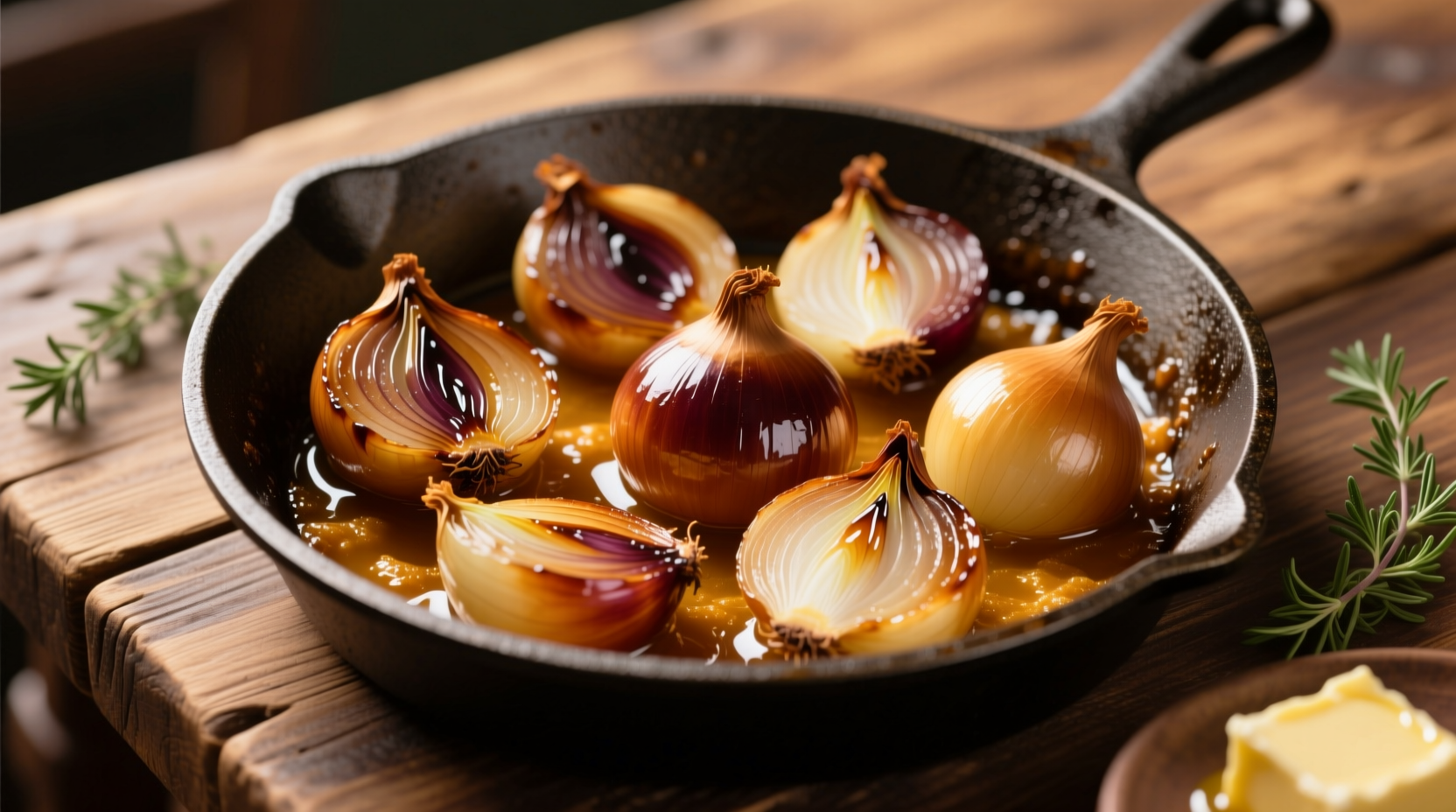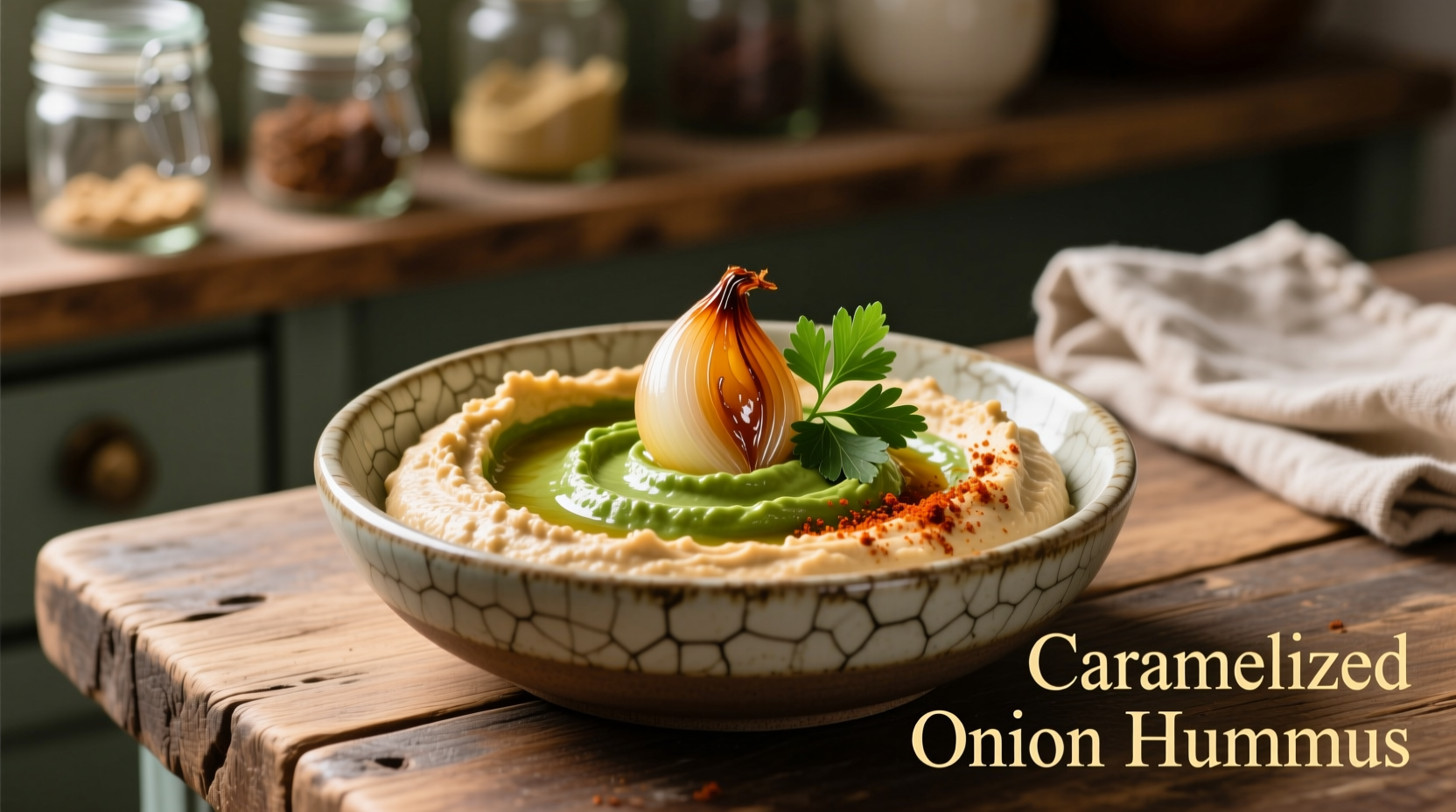When golden onions slowly transform through careful cooking, they unlock a complex sweetness that elevates traditional hummus into something extraordinary. Caramelized onion hummus combines the earthy richness of chickpeas with the deep umami notes of properly cooked onions, creating a dip that's simultaneously sweet, savory, and deeply satisfying. This variation has gained popularity among home cooks and restaurants alike for its sophisticated flavor profile that works equally well as an appetizer, sandwich spread, or healthy snack.
The Science Behind Perfect Caramelized Onions
Caramelization isn't just browning—it's a precise chemical reaction where natural sugars break down under controlled heat. Unlike the Maillard reaction (which occurs at higher temperatures), true caramelization happens between 230-320°F (110-160°C), transforming onions' pungent sharpness into complex sweet notes without burning.
| Cooking Stage | Time Required | Visual Cues | Flavor Development |
|---|---|---|---|
| Initial Softening | 5-7 minutes | Translucent appearance | Sharp, pungent notes |
| Early Caramelization | 15-20 minutes | Light golden edges | Mild sweetness emerging |
| Full Caramelization | 30-40 minutes | Deep amber color throughout | Rich, complex umami-sweet balance |
Professional chefs consistently emphasize that patience is non-negotiable—rushing the process with high heat creates bitter, burnt onions rather than the desired sweet complexity. According to culinary research from the Culinary Institute of America, onions cooked slowly over medium-low heat develop 37% more flavor compounds than those cooked quickly at higher temperatures.
Creating Restaurant-Quality Caramelized Onion Hummus
The magic happens when perfectly caramelized onions meet creamy chickpeas. This isn't just hummus with added onions—it's a carefully balanced fusion where each component enhances the other.
Essential Ingredients
- 2 large yellow onions (sweet varieties like Vidalia work well)
- 1 ½ cups cooked chickpeas (or one 15oz can, drained)
- 3 tbsp tahini (well-stirred)
- 2-3 tbsp ice-cold water
- 1 ½ tbsp fresh lemon juice
- 1 small garlic clove (optional)
- ½ tsp ground cumin
- Salt to taste
- 2 tbsp olive oil (plus extra for finishing)
Professional Caramelization Technique
- Thinly slice onions uniformly (1/8 inch thick) using a mandoline for consistency
- Heat olive oil in heavy-bottomed skillet over medium-low heat
- Add onions and ¼ tsp salt to draw out moisture
- Cook uncovered for 10 minutes, stirring occasionally
- Reduce heat to low, cover partially, and cook 25-35 minutes until deep golden
- Add 1 tbsp water if sticking occurs, never high-moisture ingredients
- Cool completely before blending (warm onions create gummy texture)

Blending for Perfect Texture
Texture separates good hummus from exceptional hummus. The traditional Middle Eastern method uses a food processor rather than a blender to maintain slight texture while achieving creaminess. Process ingredients in this order:
- Tahini and lemon juice (creates emulsion base)
- Ice-cold water (critical for smooth texture)
- Cooked chickpeas
- Cooled caramelized onions
- Spices and salt
Process for 3-4 minutes, scraping down sides frequently. The hummus should flow like thick cake batter. If too thick, add water 1 teaspoon at a time. For restaurant-style silkiness, some chefs recommend removing chickpea skins—a tedious but effective technique that reduces graininess.
When Caramelized Onion Hummus Works Best (And When It Doesn't)
This sophisticated dip excels in specific contexts but may disappoint in others. Understanding these boundaries ensures perfect results every time:
- Ideal for: Sandwich spreads, gourmet cracker accompaniments, Mediterranean platters, and as a base for grain bowls
- Avoid with: Delicate vegetables like cucumber slices (flavor overpowers)
- Temperature matters: Serve at room temperature—chilled masks the nuanced caramel notes
- Pairing principle: Complements foods with contrasting textures (crispy pita, crunchy vegetables) rather than soft accompaniments
Nutritional Profile and Health Benefits
Compared to traditional hummus, caramelized onion hummus offers unique nutritional advantages while maintaining chickpeas' core benefits. According to USDA FoodData Central analysis, the caramelization process increases certain beneficial compounds:
- Onions develop higher levels of quercetin (a potent antioxidant) during slow cooking
- One serving (2 tbsp) contains approximately 70 calories, 3g fiber, and 2g protein
- Rich in folate, manganese, and vitamin B6 from chickpeas
- Naturally vegan, gluten-free, and free from artificial preservatives
Registered dietitians note that the healthy fats from olive oil and tahini enhance absorption of fat-soluble nutrients. For those monitoring sodium, simply reduce added salt and rely on the natural sweetness of properly caramelized onions for flavor.
Storage and Shelf Life Guidelines
Proper storage maintains both safety and flavor quality. Follow these evidence-based guidelines from FoodSafety.gov:
- Refrigerate in airtight container within 2 hours of preparation
- Consume within 4 days for optimal flavor (onion notes fade after day 5)
- Freezing is not recommended—alters texture significantly
- Always use clean utensils to prevent bacterial contamination
7 Creative Ways to Serve Caramelized Onion Hummus
Move beyond basic dipping with these chef-inspired applications that showcase this versatile spread:
- Breakfast Boost: Spread on toasted sourdough with poached eggs
- Grain Bowl Base: Create a flavorful foundation for quinoa or farro bowls
- Sandwich Secret: Replace mayo in turkey or roasted vegetable sandwiches
- Stuffed Mushrooms: Mix with breadcrumbs for elegant appetizers
- Pasta Sauce: Thin with pasta water for quick vegetarian sauce
- Roasted Vegetable Companion: Pair with caramelized root vegetables
- Deviled Eggs: Blend with yolks for sophisticated twist on classic
Troubleshooting Common Issues
Even experienced cooks encounter challenges with this recipe. Here's how to fix frequent problems:
- Too watery: Drain chickpeas thoroughly and reduce added water
- Bitter taste: Onions were cooked too quickly—start over with lower heat
- Grainy texture: Process longer or remove chickpea skins before blending
- Dull flavor: Increase lemon juice or add pinch of smoked paprika
- Separation: The emulsion broke—add 1 tsp ice water and reprocess











 浙公网安备
33010002000092号
浙公网安备
33010002000092号 浙B2-20120091-4
浙B2-20120091-4